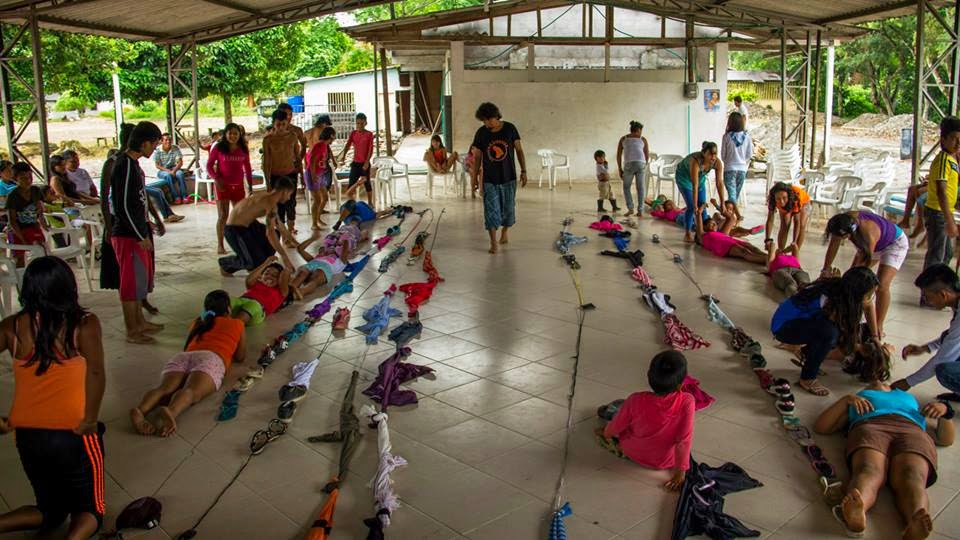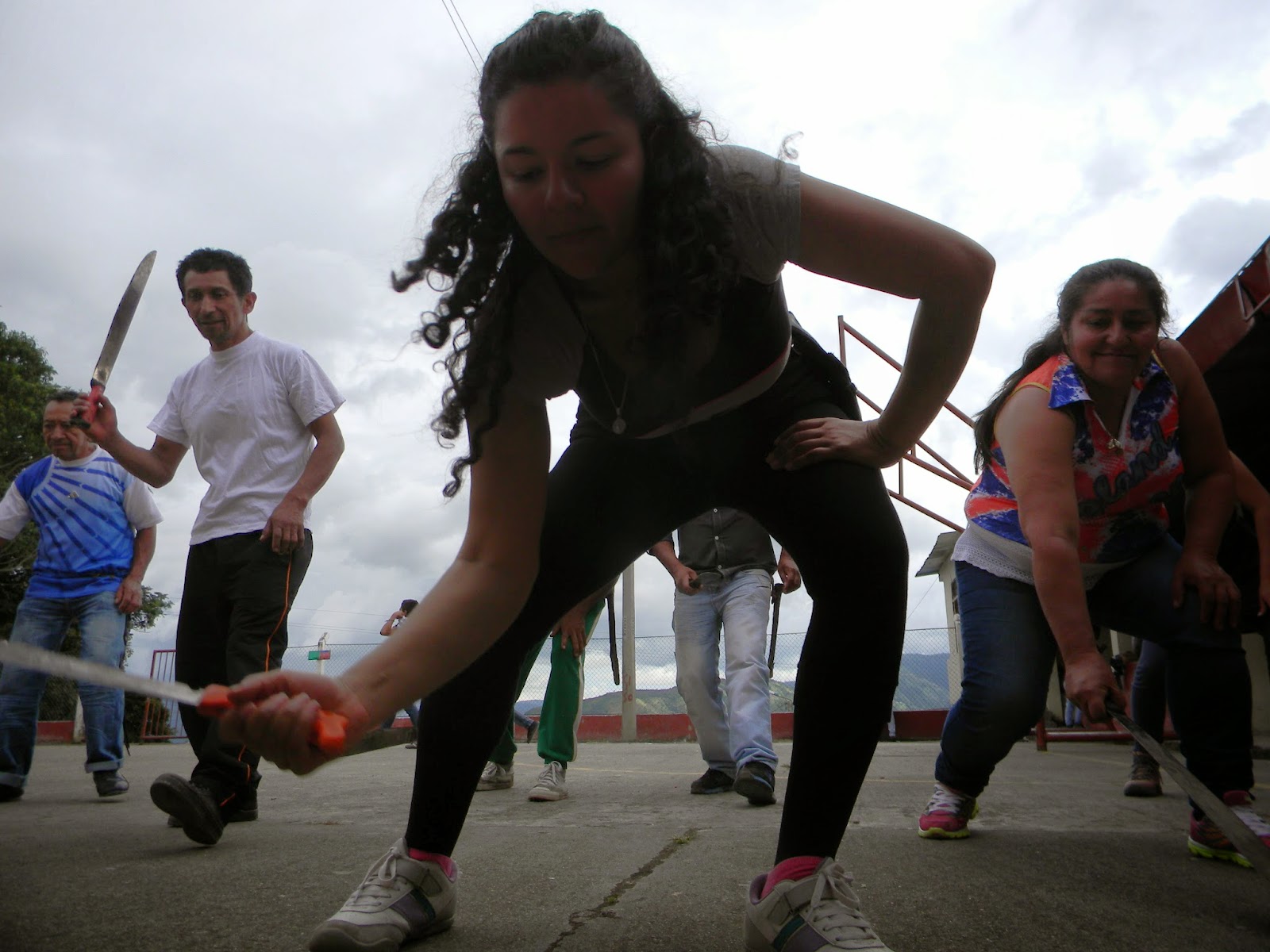 |
| Traditional Lunar Calendar in Sibundoy |
In 2010 it took place in Popayán, at the same time as the First Continental Summit of Indigenous Communication, in the indigenous reserve of La María, Piendamo.
 |
| Mural against mining in San Andres. |
 |
| Film screening with elders in Sibundoy. |
In 2013, back in Bogotá, Daupará had a wide showing of national and international audiovisual material. Communicators from all over the country participated, from Arhuaco, Wiwa, Uitoto, Kamentza Biya, Kankuamo, Wayuu, Sáliba, and Nasa communities, and it also included participation from other indigenous peoples and lands: Kichwa from Ecuador, Wayuu from Venezuela, Mapuche from Wallmapu and Diné (Navajo) from the US.
 |
| Painting classes in Nueva Esperanza |
 |
| Getting ready to paint in Nueva Esperanza |
 |
| Communications workshop in Nueva Esperanza |
Another special feature of this year's Festival was that it was a traveling show, moving between different areas of Putumayo. And the most special part of the Festival was that it was a training process for Nasa, Inga, Cofán, and Siona youth who participated in the whole tour, along with people from other indigenous communities and communication collectives from other parts of Colombia. At every stop of the Festival, the Beehive's Mesoamérica Resiste banner was present, and we did storytelling with it in many locations.
 |
| Reading Huellas & Raíces Newspaper in Nueva Esperanza |
 |
| Painting in Kiwnas Çxhab Nasa Reserve |
From the Andean region of upper Putumayo, the Festival continued to the Amazonian Footshills of central Putumayo, with the second stop in the capital city of Putumayo, Mocoa, where the Festival took place in Nueva Esperanza, a settlement of displaced people. Nueva Esperanza is a neighborhood made up of 230 displaced indigenous, rural, and afro descendant families from different parts of the country who started arriving there about 13 years ago due to violence related to the armed conflict, drug trafficking, mega development projects and mining.
 |
| Mesoamérica Resiste workshop in Kiwnas Çxhab Nasa Reerve. |
The people of Nueva Esperanza have had to organize themselves and have been fighting for their rights since the first families arrived. The Association of Displaced People of Nueva Esperanza has formed committees of elders, women, and children, as well as a newspaper called Huellas y Raíces (Footprints and Roots). Along with learning about Huellas y Raíces and sharing experiences, women, children, and others in the community did a Historical Memory workshop with photography, muralism, and graffiti, and in the evening there were screenings of the different films that were part of the Festival.
 |
| About 20 oil 18-wheeler trucks cross the Putumayo River daily. |
From the Amazonian Foothills the Festival descended finally to the biggest region of Putumayo, the Amazonian plains. In the city of Puerto Asís it crossed the Putumayo river by boat to be able to arrive at its third stop, in the Kiwnas Çxhab Nasa Reserve where during the day there was a discussion about Journalism in Situations of Risk and Territorial Defense, a presentation of the Mesoamérica Resiste graphic was done, the painting of various murals and graffiti occurred and some activities about communication in the form of games with the children of the reserve, at night there were film screenings for the community.
 |
| Learning through play in Nuevo Amanecer |
The next day we crossed the Putumayo river again to return to Puerto Asís, this time to the neighborhood of Nuevo Amanecer. Nuevo Amanecer is a community on the outskirts of Puerto Asís founded by indigenous peoples from different parts of the Putumayo river who have been displaced by violence, aerial fumigations, and oil companies. Another project of IIRSA related to the displacement of families that live in Nuevo Amanecer today is the canalization of the Putumayo river, which is to facilitate the entry of large cargo ships into this river that is populated by diverse communities of humans and ecosystems. The inhabitants of Nuevo Esperanza are predominantly Siona, but there are also Embera Chamí, Cofán, Nasa, and Murui families. During the day there was a conversation about the importance of communication in these communities, followed by a presentation of Mesoamérica Resiste. At night there were screenings of a variety of films from the Amazon, as well as from other places.
 |
| Embera Chamí music in Nuevo Amanecer. |
From Puerto Asís we traveled along the Trans Amazonian highway that is under construction as part of IIRSA, passing through Orito to arrive at the Cofán Ethno-Education Boarding School of Santa Rosa de Guamuez. Along the whole route from Puerto Asís, through Orito and to the Valle del Guamuez and la Hormiga, we could see oil pipelines carrying the poorly named black gold away from the region. Around the community of Santa Rosa del Guamuez there are petroleum extraction installations that belong to ECOPETROL, which is contaminating water and land throughout the Colombian Amazon and in areas very close to indigenous communities where they never did any kind of consultation, much less have they respected the widely recognized opposition to petroleum extraction.
 |
| Oil extraction within Cofán community of Santa Rosa del Guamuez. |
Although it's been in existence for 12 years, the Beehive's Plan Colombia graphics campaign still shows a reality that continues to exist in Putumayo's territory. Although happening in a very difficult context, this place had some of the most special elements of the Festival, as this community was the host of the second bi national gathering (Colombia-Ecuador) of the Cofán people which had started just a few days before, and as part of the final activity of the last day, the Daupará Festival arrived and presented to the community the film “Nuestra Madre Tierra Enferma", a co-production between the School of Intercultural Communication and this community. All of the Cofán people present at the gathering were able to view the work that had been done to raise awareness about the problems with the oil companies in this region. The next day there was a communications workshop in the form of games with many children and adolescents from the community, and amongst the games, smiles and acrobatics, the dynamics helped emphasize the importance of communication in all aspects of community life.
 | ||
| Play and communication in Santa Rosa del Guamuez. |
With much sadness and nostalgia of the lovely week, after finishing the tour of the 6th version of Daupará each group and delegate said goodbye and returned to their communities and territories to keep walking the paths we are on, now with new experiences and knowledge to carry with us. For many people on the 2014 Daupará Festival team, this trip was just the beginning of getting to know Putumayo, and some people on the team, including ourselves as bees, are planning other activities with these communities to keep weaving and walking together this year.
 |
| Cofán Indigneous Guard. |
This year Daupará returns to Bogotá and from there they will decide which territory will host it for 2016. One thing was clear after this last Daupará, that even with less of a budget and less support, the Festival was able to really reach impacted communities and support the process of training indigenous youth from four different areas of Putumayo in communications. We hope the Putumayo School of Intercultural Communication gets recognition for how it has raised the bar of Daupará from being not only a showing of audiovisual material, to also being a process that supports the training of indigenous communicators and raises awareness of the issues and the resistance movements in indigenous communities.




























